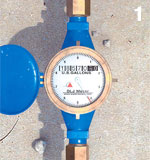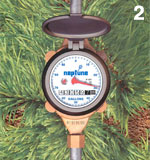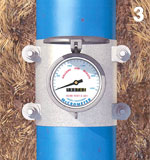Reading and understanding your water meter is important in tracking and managing your groundwater use. As a permit holder, you are required to record how much Edwards Aquifer groundwater you use on a monthly and annual basis, and to report this information to the EAA each year. These reports should include meter readings for the amount of groundwater pumped from your well(s). Monitoring and accounting for your groundwater use throughout the year helps the EAA manage the aquifer, and can help you avoid pumping more than your annual authorized withdrawal amount.
Determining Your Water Use
As outlined in EAA rules, all permit holders or contract users are required to accurately read each well’s meter on both a monthly and annual basis. To determine monthly use, subtract the first reading from the second reading. To determine annual use, subtract the January 1 meter reading from the December 31 meter reading from the annual groundwater withdrawal report. The calculated amount is the annual water use for that year. The December 31 reading is also the beginning meter reading for the following year.
3 Ways to Report Your Usage
Here you can submit and track your monthly and annual groundwater use reports. Once filed through this system, you may view prior reports by going to the Reports section of your registered account.
Printable Forms
Fill-out and return the provided contact form to update your information. Additional forms are provided to register or replace your meter.
How to Read Your Meters
Reading a water meter is similar to reading the odometer in your car. Learning how to read your meter correctly can help you identify leaks and discover ways to conserve water. Of the many types of meters used on the market, the following examples include three of the more common meters used throughout the region.
Example #1

On the face of the meter there is a large dial and a display of numbers. Read and record the number display from left to right exactly as it appears, including any fixed zeros to the right of the number shown. The face of the meter indicates this meter reads in gallons.
Meter #1 (above) reads 1,857,030 total gallons. Notice that the zero at the end is included in the reading, and no decimal points have been added.
To convert this number to acre-feet, divide the total gallons by 325,851 (325,851 equals one acre-foot).
For example: 1,857,030 / 325,851 = 5.699 total acre-feet.
Example #2

On the face of the meter there is a large dial and a display of numbers. Read and record the number display from left to right exactly as it appears, including any fixed zeros to the right of the number shown. The face of the meter indicates this meter reads in gallons.
Meter #2 reads 43,059,700 total gallons. Notice that the set zeros at the end of the dial are included in the reading, and no decimal points have been added.
To convert this number to acre-feet, divide the total gallons by 325,851 (325,851 equals one acre-foot). For example: 43,059,700 / 325,851 132.145 total acre-feet.
Example #3

The dial reads 183750 and the face of the meter indicates this meter reads in acre-feet X .001
Therefore, Meter #3 reads 183.750 acre-feet.
Automated Meter Reading (AMR)
In 2004 the EAA began designing a remote meter to replace analog meters on a voluntary basis for our Irrigation Permit Holders. This electronic meter is designed to limit human error, reduce manpower and eliminate mechanical malfunctions or tampering while maintaining the integrity and function of the original analog meter. A retrofitted, non-invasive sensor ring with a pulse output was developed by the EAA to convert existing meters into electronic meters. To make the conversion, the sensor ring is fitted around the existing mechanical register.